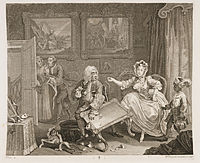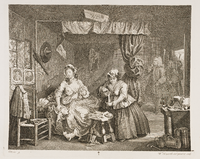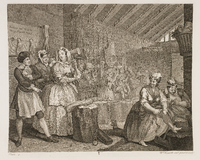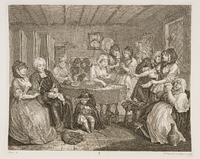A Harlot's Progress
A Harlot's Progress (dt .: The CV of a prostitute is) a series of six paintings and six engravings by the English artist William Hogarth , which he 1730 / 1731 and 1732 created. The paintings fell victim to a fire in 1755, during Hogarth's lifetime. Only the copperplate engravings have survived.
The series shows the résumé of a young woman named M. (Moll or Mary) Hackabout, who comes to London from the provinces and becomes a prostitute. In the first scene an old matchmaker recognizes the beauty of the innocent-looking girl and considers her suitable for having paid sex with men like the lecher who is shown in the picture behind her. In the second picture she is the mistress of a wealthy merchant, in the third picture a common prostitute who is arrested by the Westminster judge Sir John Gonson. In the fourth scene you can see her knocking on hemp while on duty in Bridewell Prison. In picture 5 she dies of a sexually transmitted disease in a hovel. Scene 6 shows the mourners celebrating shortly before the funeral of the young girl who died young.
background
At first there was only the third picture in the series, which shows a prostitute in her boudoir in Drury Lane, but Hogarth soon came up with the idea of depicting scenes from her earlier and later life, so that ultimately a six-part series of pictures of the life of a prostitute emerged. The six pictures belong to the artist's "modern moral subjects", i. That is, on the modern moral issues that illuminate the social problems in the English 18th century in the manner typical of Hogarth critically and satirically. The title of the series and the allegorical allusions in the pictures are reminiscent of John Bunyan's Christian book of edification, The Pilgrim's Progress , although the scenes proclaim anything but Christian morality.
The protagonist "M. Hackabout" (compare the inscription on the coffin lid in scene 6) was named either after the heroine of Daniel Defoes Moll Flanders , after the prostitute Kate Hackabout, sister of the 1730 hanged Schnapphahn Francis Hackabout, or ironically after the holy one Virgin Mary named. In English, "to hack" also stands for "rent" or "whore".
The series was very successful and Hogarth sold 1,240 copies of the six prints for 1 guinea each. Pirated copies of the engravings were soon put into circulation, which is why Hogarth, together with some artist colleagues, ensured that a copyright law (8 Geo II, Chapter 13) was passed in 1735 to protect English engravers from the machinations of the pirates.
The six pictures in the series of engravings
Scene 1: M. Hackabout arrives in London
Moll or Mary Hackabout has just arrived in London. She is carrying scissors and a small pin cushion, which suggests that she was looking for a job as a seamstress. Instead, she is seized by Elizabeth Needham, a notorious matchmaker who wants to win the pretty girl into prostitution. The lecher and molester Colonel Francis Charteris and his pimp are already interested in the innocence of the country. The two stand in front of a dilapidated inn, symbolic of their moral bankruptcy.
Moll wears a white dress in contrast to the people around her, which illustrates her innocence and naivete. A clergyman ignores the girl's predicament, just as he ignores the fact that his horse knocks over a pile of pots. A dead goose in Moll's luggage is meant for her "lofing cuseng" ("My lofing cosen in Tems Stret in London"). This goose already refers to Moll's early death. The pub sign, on which a bell (English "bell" for Bell Inn) is depicted, could also refer to the beauty of the girl (French "belle"). The toppling pile of pots, however, alludes to Moll's impending "fall".
The composition resembles a visitation scene , ie the visit of Mary to Elisabeth, as described in Luke 1, verses 39–56.
Scene 2: Moll as the courtesan of a rich businessman
Moll is now the lover of an ugly depicted, rich Jewish merchant, as confirmed by the Old Testament images in the background, which show the prophet Jonah and Usa , who was not killed by God, but by a priest , and which can be seen as prophetic, like him Kaufmann will treat minor between this scene and the third picture.
Details in the picture show that the whore lives big and has developed numerous lavish tastes, both with regard to her expensive clothes and to her companions in the form of a servant, a young West Indian page and a costumed monkey. A mask, remnant of a masquerade festival known at the time for its debauchery, refers to immoral goings-on. Moll knocks over the tea table so that the merchant is distracted and behind him, her real lover, accompanied by the servant, can tiptoe out of the dust without being noticed.
Scene 3: The Whore's Arrest
Moll is no longer a courtesan, but just a mean prostitute. So the rich merchant must have parted with her. Your maid is old and afflicted with syphilis. A four-poster bed is the only larger piece of furniture, and the cat in front of the bed poses like a sexually offering whore. The witch hat and birch rod on the wall could either suggest black magic or that prostitution is a diabolical trade. Pictures on the wall under the window show portraits of Moll's heroes: the Highwayman and pirate Captain Macheath from John Gay's Beggar's Opera and the popular clergyman Henry Dingverell . Two remedies for syphilis are above the pictures on the windowsill. Another picture shows Abraham who wants to sacrifice his son Isaac. The wig box of the mugger James Dalton, who was hanged on May 11, 1730, over the bed indicates that this criminal was the whore's lover. The judge Sir John Gonson comes through the door on the right with three armed thugs to arrest Moll for their activities. Moll holds a watch (perhaps a gift from Dalton, perhaps stolen from a suitor) and shows the viewer her left breast.
The composition satirically resembles an Annunciation , ie the announcement by the angel Gabriel that the Virgin Mary will become the mother of the Son of God through the action of the Holy Spirit, as Luke 1, verses 26–39, describes. Judge Gonson takes on the role of the angel and the whore sitting on the bed the role of the Virgin Mary.
Scene 4: Moll has to knock hemp in prison as a punishment
Moll is the Bridewell- penitentiary been brought. She beats hemp to make gallows ropes while the prison guard threateningly makes her work. The prison guard's wife tugs at Moll's clothes with a wink. The prisoners were depicted from left to right in order of decreasing wealth. Moll is standing next to a cardsharp whose extra playing card fell and who brought his dog with him. Further back, other women are tapping hemp, including a minor and finally a pregnant black woman who was not allowed to be executed because of the child in her belly and was also not allowed to be transported to the colonies as a slave. Moll's maid is smiling in the front right of the picture. She seems to be wearing her whore's shoes. The prisoners are not reformed in any way, despite the ironic inscription above the punishment block or bondage stick on the left, where it reads: "Better to work / than to be in the pillory". The person with their hands attached to the block apparently refused to work. A prison graffiti shows Sir John Gonson on the gallows.
Scene 5: The death of the prostitute
Moll sits next to her bed and dies of syphilis. Dr. Richard Rock (with dark wig) and Dr. Jean Misaubin (with a light wig) argue about their medical methods, bloodletting (which Dr. Rock recommends) and cupping (which Dr. Misaubin prefers). A woman, possibly a servant or the landlady, rummages in Moll's box for things that she would like to take with her. Meanwhile, Moll's maid tries to stop the looting and fend off the doctors' argument. Moll's son, who presumably acquired the venereal disease from his mother, sits by the fire and removes lice or fleas from his hair.
The only clue to the owner of the apartment is a Passover cake hanging on the wall that is used as a fly trap, which could well mean that Moll's former master, the Jewish merchant from scene 2, is still paying for her in her final days that, unlike the Israelites, it will nevertheless perish. Various medical "remedies" or references to them are scattered on the floor. Moll's laundry on the line seems to want to reach for her as if they were dragging ghosts into the afterlife.
Scene 6: Moll's funeral
In the last scene Moll died and you can see numerous mourners from the prostitute milieu shortly before the funeral in the undertaker's room. A note on the coffin lid indicates that "M. Hackabout died on September 2, 1731 at the age of 23". The pastor spills his brandy as he tinkers with his hand under the skirt of the whore sitting next to him. A woman who has put drinks on Moll's coffin looks disapproving. Moll's son sits on the floor and, unimpressed by the action, plays with a top in front of the coffin.
A matchmaker consoles herself on the right with a jug containing brandy from "Nant [e] s". She is the only one to mourn Moll's death. One of the prostitutes present steals the undertaker's handkerchief. Another prostitute shows her injured finger to a colleague, while another whore admires her appearance in a mirror despite the syphilitic wound on her forehead.
On the wall behind the coffin hangs a coat of arms as an ironic hint, which shows three taps, which remind of the "spillage" of alcohol by the pastor. The white hat hanging on the wall next to the coat of arms was worn by Moll in the first scene. Now she lies dead in the coffin, but as you can see, prostitution goes on without her.
The story as a film and as a modern opera
A Harlot's Progress is also the title of a British film that firstairedon Channel 4 onNovember 2, 2006, starring Zoe Tapper, Toby Jones , Sophie Thompson , Richard Wilson and Geraldine James . Directed by Justin Hardy . The whore here is called Mary Collins. The story is loosely based on Hogarth's six-part series of images.
The English composer Iain Bell wrote the opera A Harlot's Progress (Libretto: Peter Ackroyd ) based on Hogarth's cycle for the soprano Diana Damrau in the title role, which was performed on October 13, 2013 in the Theater an der Wien under the musical direction of Mikko Franck and in the Production by Jens-Daniel Herzog was premiered.
Footnotes
- ^ Paulson, Ronald: Hogarth , Volume 1: The "Modern Moral Subject", 1697-1732 . Rutgers University Press, New Brunswick 1991, p. 372, note 3.
- ^ Paulson, Ronald: Hogarth's Graphic Works . 3rd ed. The Print Room, London 1989, pp. 80-81.
- ^ Hallett, Mark: The Spectacle of Difference. Graphic Satire in the Age of Hogarth . Yale University Press, New Haven and London 1999, pp. 100-101.
- ^ Paulson: Hogarth's Graphic Works , p. 77.
- ^ Paulson: Hogarth , Volume 1, p. 247.
- ↑ Buschhoff, Anne: "William Hogarth became famous overnight: The series of copper engravings 'Der Weg einer Dirne'" ( Memento of the original from February 13, 2017 in the Internet Archive ) Info: The archive link was inserted automatically and has not yet been checked. Please check the original and archive link according to the instructions and then remove this notice. . Kunsthalle Bremen blog, June 16, 2014.
- ^ Paulson: Hogarth's Graphic Works , p. 76.
- ^ Paulson: Hogarth's Graphic Works , p. 77. Ders .: Hogarth . Volume 2: High Art and Low, 1732-1750 . Rutgers University Press, New Brunswick 1992, pp. 35-47. Döring, Jürgen: "The importance of the Hogarth Act of 1735 for English graphics and their relationship to daily literature." In: Möller, Joachim (Ed.): Sister Arts. English literature in the borderland of art . Jonas, Marburg 2001, pp. 38-50.
- ^ Paulson: Hogarth's Graphic Works , p. 78.
- ^ Paulson: Hogarth , Volume 1, p. 248.
- ^ Paulson: Hogarth's Graphic Works , p. 78.
- ^ Paulson: Hogarth , Volume 1, p. 273.
- ^ Paulson: Hogarth's Graphic Works , pp. 79-80.
- ^ Paulson: Hogarth's Graphic Works , p. 81.
- ^ Paulson: Hogarth , Volume 1, p. 273.
- ^ Paulson: Hogarth's Graphic Works , p. 82.
- ↑ Harrington, Jo: Movie Review of A Harlot's Progress (2006)
- ^ Stürz, Franziska: Merciless passion of a whore. Iain Bell's first opera "A harlot's progress" premiered at the Theater an der Wien. Deutschlandradio , October 13, 2013.
literature
- Bindman, David: Hogarth . Thames and Hudson, London 1981. ISBN 050020182X
- Einberg, Elizabeth: William Hogarth. A Complete Catalog of the Paintings . Yale University Press, New Haven and London 2016.
- Hallett, Mark: The Spectacle of Difference. Graphic Satire in the Age of Hogarth . Yale University Press, New Haven and London 1999.
- Hinz, Berthold et al .: William Hogarth 1697–1764. The complete graphic work. 2nd edition Anabas-Verlag, Giessen 1986.
- Lichtenberg, Georg Christoph: The Harlot's Progress - The way of the wooer. In: Promies, Wolfgang (Ed.): Georg Christoph Lichtenberg: Writings and letters . Third volume. Hanser, Munich 1972, pp. 732-818.
- Paulson, Ronald: Hogarth's Graphic Works . 3rd ed. The Print Room, London 1989.
- Paulson, Ronald: Hogarth , Volume 1: The "Modern Moral Subject", 1697-1732 . Rutgers University Press, New Brunswick 1991.
- Shesgreen, Sean: Engravings by Hogarth 101 Prints. Dover Publications, New York 1973. ISBN 0-486-22479-1 .
- Stephens, Frederick George: Catalog of Political and Personal Satires, Volume III, part I . British Museum Publications, Ltd., London 1978.
- Wagner, Hans-Peter: William Hogarth: The graphic work: An annotated selection catalog . WVT Wissenschaftlicher Verlag Trier 2013.
See also
Web links
- Lichtenberg, Georg Christoph: Detailed explanation of the Hogarthische Kupferstiche: The Harlot's Progress. The way of the fanatic.
- Krysmanski, Bernd: A Harlot's Progress by William Hogarth. Rise and fall of a whore. A brief overview for German readers.
- Buschhoff, Anne: William Hogarth became famous overnight: The series of copper engravings "The path of a prostitute".
- Milne, Anne (and their students): The Harlot's Progress in Context. Website, University of Toronto Scarborough (winter semester 2015/16).
- Ardelie, Susan: Hogarth's The Harlot's Progress.






